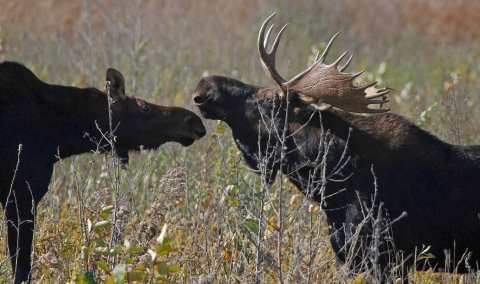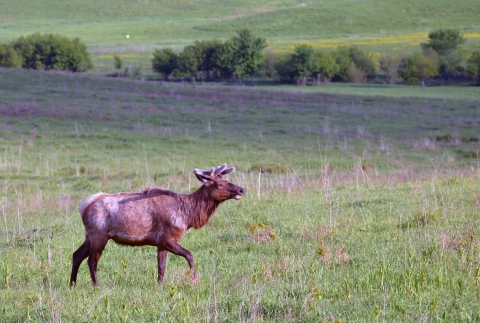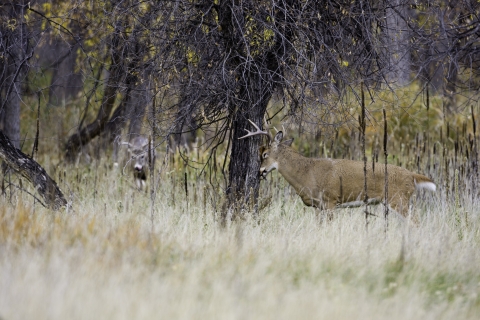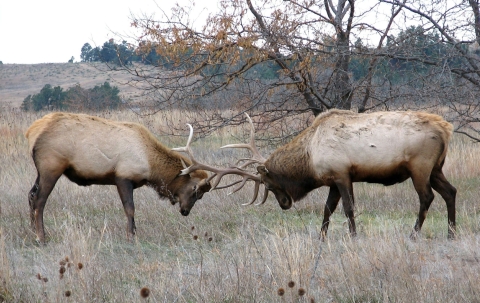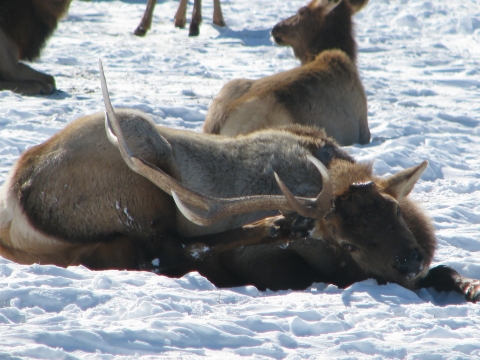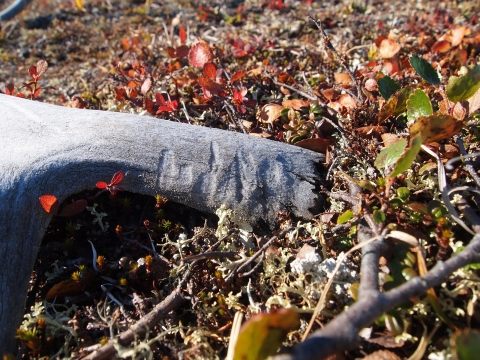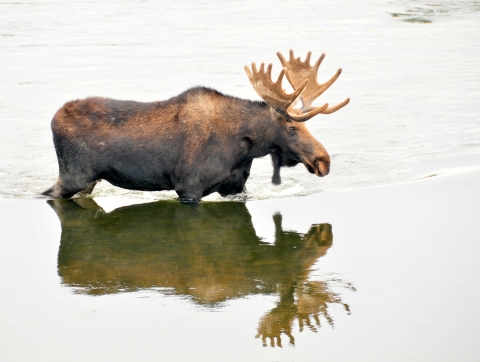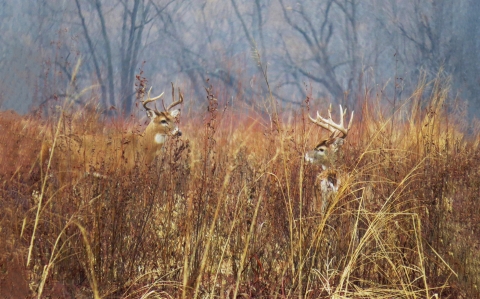In the fall, antlers are everywhere, from water cooler talk about the whitetail season to fall decor. If you’ve found yourself surrounded with antler talk this fall and need a few pointers, we at U.S. Fish and Wildlife Service can help!
Finding shed antlers is an exciting part of hiking and wildlife watching. Remember it’s illegal to take natural items from many public lands. Rules and regulations governing possession of animal parts vary between states and even different designations of federal land. Legal shed collection may have set seasons and may require a permit. If shed antler collecting is allowed, you should always follow ethical collecting practices - give wildlife their space and protect sensitive habits by staying on roads and paths. You can always share your experience by photographing your find and leave it in place to remain a valuable part of the ecosystem.
Point 1: Antlers are not horns
Animals in the deer family grow antlers. Antlers are branched bones that are shed every year. In midwestern states, white-tailed deer, elk and moose have antlers. Unsurprisingly, the largest antlers are found on the largest deer species - moose! Other North American animals with antlers include mule deer and caribou. Caribou, also known as reindeer, are the only species where both males and females have antlers.
Animals in the bovine family grow horns. Horns are permanent bones covered with keratin, the same material as our fingernails. Bovine animals include wildlife like bison, bighorn sheep, mountain goats and domestic animals like cattle, goats and sheep. Both males and females have horns.
Point 2: Antlers are fast growing
Antler growth is incredibly fast. In fact, antlers are the fastest bone growth in the world. Just a few weeks after a white-tailed deer or elk sheds its antlers, a new set begins to grow. Growth is triggered by increasing daylight and subsequent testosterone production. Adult white-tailed deer antlers can grow ¼ inch per day, whereas elk antlers grow about an inch per day. Moose regrow a few months after shedding, making their growth rate even more impressive. A moose in his prime can grow as much as a pound of antler per day!
Genetics and age play a role, but the driving force behind large antler growth is good nutrition. Having a healthy and protein rich diet can lead to a stunning rack. Therefore, high quality habitat is a must!
Point 3: Velvet can be itchy
Immature antlers are covered in skin with a short, dense fur called velvet. Velvet allows oxygen rich blood to reach growing antlers, which start as cartilage and are calcified into bone. Abnormalities in antlers can be due to injuries to the velvet or genetics.
Growing antlers is costly. In poor habitat, a buck’s bone density will decrease as his body will take the calcium and put it toward hardening antlers. Bull moose will spend a quarter of the energy from the 35 pounds of vegetation they eat each day toward growing antlers. Cow moose use these energy to prepare for winter. This may be why female moose live longer than males.
Once antlers reach their final size, the velvet dries and becomes itchy. You’ll see deer, elk and moose rubbing their newly formed antlers on trees and other vegetation to remove the velvet. As velvet is skin, rubbing it off can look very gruesome. But it’s unlikely you’ll see this, as white-tailed deer can remove all their velvet in as little as 24 hours.
Point 4: Antlers are used for saber rattling more than as a saber
Antlers are costly to grow, but necessary during the deer breeding season or rut. As the rut starts, males continue to rub their antlers on vegetation to scent mark and begin sparring with each other to determine dominance. Dominant males may offer an antler to young males for sparring. The sound of antlers rattling will draw other males to the area, as sparring is an important part of deer social behavior. As the season progresses, sparring ends and serious competition for females begin. Posturing is usually enough, but sometimes two equally matched males will fight. Fighting includes locking antlers and pushing. Once the loser backs down, the winner may swipe at the loser as he runs away.
Point 5: Winter is the best time to shed some pounds
Once the fall rut is over, why carry around extra weight? Antlers have served their purpose and can be discarded. Antlers are heavy and can be cumbersome for males whose primary interest is now eating enough to survive the winter. Decreased daylight triggers lower testosterone production which causes the connection between the antler and the skull to weaken.
Deer antlers can vary in weight from 3 to 9 pounds. Healthier deer will have heavier antlers because the bone is dense from good mineralization. A bull elk in his prime could have an antler spread of four feet, with each antler weighing 20 pounds. Moose antlers spreading six feet weigh about 40 pounds each.
Point 6: One animal’s trash is another animal’s treasure
Deer, elk and moose may enjoy the increased mobility for foraging after they shed antlers. Other animals are excited to find shed antlers during their foraging.
Many nutrients are needed to make bone, such as calcium, phosphorus and protein. These nutrients are important for all types of animal growth, not just big strong antlers. Rodents in particular love shed antlers - mice, squirrels and porcupines will gnaw on antlers for their nutrients and to wear down their ever growing teeth. Even bears, foxes, opossums and otters have been known to eat antlers. Because antler sheds are important for healthy habitat, antler shed hunting is illegal in many places. If you buy antler products make sure they are legally sourced.
Point 7: Count candles, not points
If antlers are shed each year, can they be used like tree rings to age an animal? No, typically antlers are not a reliable way to determine an animal's age. What antlers do indicate is the health and fitness of an animal. The one case where you can be fairly certain that antlers are a good indication of age is for yearling deer and elk, which have spikes rather than branched antlers. Older doesn’t always mean bigger antlers. Deer, elk and moose past their prime will have smaller, less dense antlers. White-tailed deer will have the largest antlers in their prime years from 4 to 6, elk between ages 9 to 12, and moose from ages 5 to 10.
Point 8: How do you count points?
You’ll often hear white-tailed bucks and bull elk described by their number of points. Points are tines branching off the main beam of the antler that measure at least 1 inch. Additional attributes are measured by hunters to score an animal such as such as spread, main beam length and length of points. In white-tailed deer, eight points is the most common antler type. Eight point deer are usually 3 or 4 year-old bucks but also aging bucks and bucks living in poor habitats. White-tailed deer are described by the total number of points but elk are counted by each side. For example, the most common mature elk antlers with six points on both the left and right antlers are called 6x6. For moose, the most common measure of size is spread - which is the total width of the antlers. Scoring moose measures also include points, width of palm, length of palm and circumference of beam at the smallest place. The palm is the central part of the antler, which looks like the shape of an outstretched hand.


